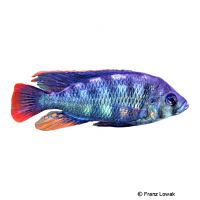Rock Kribensis (Haplochromis sauvagei)
| Rock Kribensis Haplochromis sauvagei | |
|---|---|
| Name | Rock Kribensis |
| Name Lat. | Haplochromis sauvagei |
| Synonym | Paralabidochromis sp. 'Rock Kribensis' |
| Family | Cichlids |
| Family lat. | Cichlidae |
| Order | Cichlids |
| Order lat. | Cichliformes |
| Origin | Lake Victoria |
| Habitat | Rocky intermediate zone |
| Diet | Omnivore |
| pH | 7.0-9.0 |
| Behavior | Semi-aggressive |
| Keeping | Harem |
| Care Level | Moderate |
| Reproduction | Mouthbrooder |
| Breeding | Simple |
| Life Span | 3-5 years |
| Protection | No |
| Metric Units | |
| Size | 8-10 cm |
| Temperature | 21-29 °C |
| Hardness | 4-10 °dH |
| Aquarium | 100 cm / 200 l |
| US Units | |
| Size | 3.1"-3.9" |
| Temperature | 70-84 °F |
| Hardness | 71-178 ppm |
| Aquarium | 50 gal |
Distribution and habitat
The Rock Kribensis cichlids occur exclusively (endemically) in the southern part of Lake Victoria, in Tanzania. They live there in the coastal shallow waters of the transition zone, with rocky areas and boulders.
Maintenance
The aquarium should have rock structures that rise to the water surface, with caves, crevices and shelters to provide hiding places as well as some hardy plants, a substrate of sand or fine gravel and adequate swimming space.
There should be no detectable ammonia, ammonium or nitrite, and the nitrate level should not exceed 100 mg/l. To ensure the water quality and oxygen content, a filter and heater adapted to the aquarium size is required, as well as lighting for the species-appropriate day-night rhythm of the animals.
Diet
They eat the smallest organisms from the plant cover (growth) of stones. The food supply consists of live food, such as artemia, daphnia and black mosquito larvae, which is also accepted in frozen form, or a special food mix for cichlids enriched with vitamins. In addition, they need some vegetable food, such as algae leaves. Also high quality dry food for cichlids (granules, pellets) is well accepted.
It is recommended to feed small portions several times a day. Only as much should be fed as is eaten within a few minutes. Regular and varied feeding promotes health and prevents deficiency symptoms
Behaviour and compatibility
They should be kept in a harem, one male with several females. Males among themselves behave territorially, so keeping multiple harems is only recommended in a larger and richly structured tank. They can be socialized well with other African cichlids.
Basically, only compatible fish species with similar demands on water condition and water temperature should be socialized.
Sex dimorphism
The yellow colored females have a dark stripe. Males have red, yellow-green, yellow or blue coloration.
Reproduction and breeding
They are maternal mouth brooders. Immediately after spawning on a rock, the females take the eggs, 5-30 of them, into their throat sac for mouthbrooding. They keep the fry in their throat sac even after hatching. After 3-4 weeks, the fry are released and brood care ends. During the entire brood care the female does not take any food.
Fry must be fed several times a day with special rearing food (Artemia nauplii). In community tanks breeding is hardly possible, because the fry are easy prey.
Important
In the males there are some color morphs (red, yellow-green, yellow, blue), which are probably widespread throughout the lake. In contrast to the mostly inconspicuous colored females of the other Victoria cichlids, the females of Haplochromis sauvagei show an intense yellow coloration
The well-being of the fish should be monitored regularly. Temperature should be checked daily, pH, hardness and nitrate levels at least every 14 days. Regular partial water changes are recommended, even if the pollutant load has not yet reached the upper limit. Sudden changes in water quality should be avoided. Newly introduced fish must be accustomed slowly to the water in the aquarium.
Further literature can be found in your pet store.
References
Text: petdata; Image: Franz Lowak
Source: BMELV (1998): Tierschutzgutachten - Haltung von Zierfischen (Süßwasser); ENGELMANN (2005): Zootierhaltung - Tiere in menschlicher Obhut: Fische, Verlag Harri Deutsch
- Gemäß § 21 Abs. 5 Tierschutzgesetz idgF
